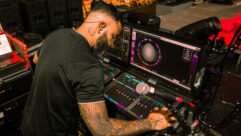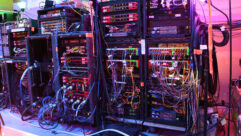
Sharing The Same Stage
Show Department, a show staging company that provides temporary staging services, tackles spatial challenges and tight time constraints for the biennial Walgreens management event.
Six video screens from The Screen Works command attention of 8,000 Walgreens managers at the company’s corporate event.
CHALLENGE: In a shortened time frame, design and install an audio-visual system that allows 8,000 audience members to see and hear presentations and live entertainment in a 12,000-seat arena.
SOLUTION: Incorporate six screens 150 feet apart and implement time-saving measures, including moving lights, pre-programmed and pre-built equipment, and rigging the site ahead of schedule.
WITH NEARLY 6,000 retail locations, Walgreens Co., is one of the fastest growing drugstore chains in the nation. Every other year, the Deerfield, Ill.–based company flies thousands of its top managers to a central location for corporate meetings. As the company steadily continues to grow — it added more than 500 stores in fiscal 2007 — the number of Walgreens Show attendees also increases, requiring the company to implement a new strategy to stage its biennial event.
This year, the Walgreens Show took place from July 29 to August 2 at the Mandalay Bay Hotel and Casino in Las Vegas and was the company’s largest ever. Its sheer size required the company to forego its traditional ballroom venue for something much bigger — a 30,218-square-foot, 12,000-seat arena at the Mandalay Bay. But creating a warm, engaging, and motivating environment for nearly 8,000 managers inside the cavernous center was no simple task.
HIGH-DEF COMMITMENT
For the Walgreens Show, Show Department incorporated eight Barco FLM HD18 projectors in the installation. One area the Chicago-based company focused on was the cable run. According to Richard Sullivan, project manager and technical director for Show Department, it was critical that the proper cables were used to deliver the HD video signals.
“Because it was such a big arena, we were talking about unusually long cable lengths. We went through the arena, up the catwalks, all the way over to the projectors,” he adds. “The farthest projector was more than 400 feet away. That was a lot of cable, and a lot of stagehands to run them.”
According to Larry Whitlow, vice president of operations for Show Department, the company has made the commitment to be completely high definition in its image acquisition and display technology. “Gear that we bought three or four years ago from Barco … supported high definition even if we weren’t able to do it at that point,” he said. “We’ve sort of grown into it.”
But how typical is it for a staging company to be completely HD? According to Chris Prosio, product application manager for Barco Media and Entertainment, Rancho Cordova, Calif., “It’s becoming more typical for staging companies to go HD. We are seeing that most of our upper-end and middle-level staging customers are moving toward HD projectors. If, for nothing else, they can continue to provide the same 4:3 aspect ratio images with the 16 x 9 projectors, and they are getting themselves ready for what is inevitable growth of HD in our industry.”
Chicago-based Show Department — a show staging company that provides temporary staging services to production companies, producers, meeting planners, corporations, and associations —worked in conjunction with Walgreens’ production department. “Our involvement started before final venue selection had been made, which was about a year and a half out,” says Richard Sullivan, project manager and technical director for Show Department.
While Walgreens worked with Show Department’s production arm, Resolution Digital Studios, to develop and produce all the video content, Show Department staged the event and supplied the technology, such as sound, lights, video, and communications. In total, it brought $11 million worth of equipment to Las Vegas for the event.
Show Department’s biggest challenge was designing the audio-visual portion of Corporate Day — the largest portion of the event and the only meeting that all attendees are together in one room — in such a way that each audience member could clearly see and hear the corporate presentations during the day and the live entertainment in the evening. Show Department also faced a scheduling conflict in the arena that shortened the already tight agenda.
Toying With the Design
Staged in the events center, Corporate Day “had to be set up to do multiple things,” says Larry Whitlow, vice president of operations for Show Department. “We had to be able to do the corporate presentations in the morning, and we had to be able to quickly turn it around and do live entertainment in the evening.” Entertainment was provided by Blue Man Group.
Only three-quarters of the arena was used for the event, which measures about 131 feet wide wall-to-wall and 246 feet long from the stage to the back wall. Because of the size of the events center, enabling each person to see and hear the meetings became a primary focus during the show’s development. Show Department created a real-time 3D model of the arena using Maxon Cinema 4D software in order to provide the perspective of any person in the events center.
For the main screen, Walgreens and Show Department selected a 20-foot x 60-foot screen with a 3:1 aspect ratio and two 16-foot x 28-foot outboard screens in 16 x 9 format. The main screen was a two-projector blend and used a total of four Barco FLM HD18 1080p projectors — two main projectors and two back-ups. Each outboard used a Barco FLM HD18 with a Barco SLM R12+ as a back-up. All projection screens were provided by The Screen Works, a division of Show Department.
FOR MORE INFORMATION
- Altman Lighting Co.www.altmanltg.com
- Barco Media & Entertainmentwww.barco.com
- Crownwww.crownaudio.com
- EAWwww.eaw.com
- High End Systemswww.highend.com
- L-Acousticswww.l-acoustics.com
- Martin Professionalwww.martin.com
- Maxonwww.maxon.net
- RiedelCommunicationswww.riedel.net
- Ross Videowww.rossvideo.com
- Shurewww.shure.com
- Sonywww.sony.com
- Telecast-Fiber Systemswww.telecast-fiber.com
- Vari-Litewww.vari-lite.com
- XTAElectronicswww.xta.uk.com
- Yamahawww.yamaha.com
Additionally, three satellite screens were installed about 145 feet away from the main center screen and 148 feet from the back wall to enhance the audience’s view. The satellite center screen was 15-feet x 45-feet with a 3:1 aspect ratio and used a Barco FLM HD18 main projector with an additional one as a back-up. The satellite outboards mirrored the main outboards.
For video, Show Department used a Ross Synergy HD switcher for five Sony PDW-F350L XDCAM HD cameras, equipped with Evertz ECAS fiber systems, two Sony HD Robocams, and one DXC-D35 camera. A Barco Encore video processor was used to switch everything downstream of the HD switcher. “Sources to the Encore included multiple high-resolution computers in addition to four Sony F70 XD Cam HD players, providing motion backgrounds for the widescreen,” Sullivan says.
Audio cabinets were from L-Acoustics. For the main hangs, nine L-Acoustics V-DOSC line array models were used on each side of the arena. Three dV-DOSC models per side were incorporated for down fills, and 18 L-Acoustics SB218 subs also were used. “Obviously, the number of subs was for the Blue Man Group because they are percussion heavy,” Sullivan explains. Crown amplifiers with XTA processing were included in the design.
To enhance sound on the left and right sides of the arena, four EAW KF850 virtual array systems were used on each side for outer fills, powered by Crown amplifiers with XTA processing. For the delays, two separate hangs of eight V-DOSC line arrays and two dV-DOSC down delays were used on each side. Other equipment included a Telecast-Fiber snake that interfaced with the video.
Two Yamaha PM1D consoles were used in the set-up — one for front of house and one to monitor mix. “Those are 96 input boards, and 72 of those inputs were used for Blue Man Group,” Sullivan says. “The rest were used for the business portion of the meeting.”
A Riedel communications system was used for behind-the-scenes communications with 30 to 35 drops and six user stations. Although Blue Man Group provided its own microphones and monitor mix, Show Department used Shure UHF-R wireless microphones for the executive presentations.
A floor plan view of the Mandalay Bay Event Center showing the six screen locations for the Corporate Day event at the 2007 Walgreens Show. The Show Department was able to pre-rig 650 feet of truss and motors to save time in a tight schedule.
“>
A floor plan view of the Mandalay Bay Event Center showing the six screen locations for the Corporate Day event at the 2007 Walgreens Show. The Show Department was able to pre-rig 650 feet of truss and motors to save time in a tight schedule.
The lighting consisted of a High End Systems Whole Hog 2 console. The general session and Blue Man Group incorporated 24 Vari-Lite CL 2000 and 48 Martin Mac 2000. For the wash, Show Department used 48 Martin Mac 2000 Profiles. Other lights included five spotlights, 24 Altman black lights, 24 Color Kinetic Color Blaze 72s for effects lighting, 12 Martin Atomic strobes, and four Martin Atomic scrolls.
Scheduling Conflicts
While time constraints are nothing new with rental staging projects, the Walgreens Show’s original contract with the Mandalay Bay allowed Show Department to take control of the venue on the Friday before the Thursday Corporate Day event if the venue was not previously contracted with another client by a certain date. And indeed, the venue wound up being contracted for Friday night, requiring Show Department to carefully plan each day in order meet its deadline.
To make up for lost time, they were able to pre-rig 650 feet of truss and motors around the perimeter of the arena on Thursday for special effects used during the Blue Man Group, which Sullivan says saved numerous hours on show site. Show Department also used all moving lights, eliminating the need for focusing. Once the lights were up, they could be programmed and focused from the board instead of stagehands focusing the lights from the rigging. “They were more expensive than conventionals,” Sullivan says. “But in the long run, it offset the need for a lot of local labor and man-hours focusing.”
Additionally, a good deal of equipment was preprogrammed and built at Show Department’s shop before it was shipped out. “It was all custom-packed for the show,” he explains. “Once we got there, it was just a matter of rolling everything off the truck, opening the fronts and backs, and start connecting.” Between the executive presentations and the Blue Man Group, the crew had a little more than six hours to reset the stage. “The only thing we did was change out what was on stage,” Whitlow says. In this case, it was a matter of dressing the main stage, reprogramming the lighting, and touching everything up.
Pre-planning is the saving grace for arena-sized events like Walgreens Show, especially when time is not on your side. “We make sure we’ve done all the legwork in advance,” Whitlow says. “The long and short of it was the install of the equipment and stage went as expected — quite simply because it was planned that way.”
Katie Parrish is a technical writer based in Independence, Mo. She can be reached at [email protected].










